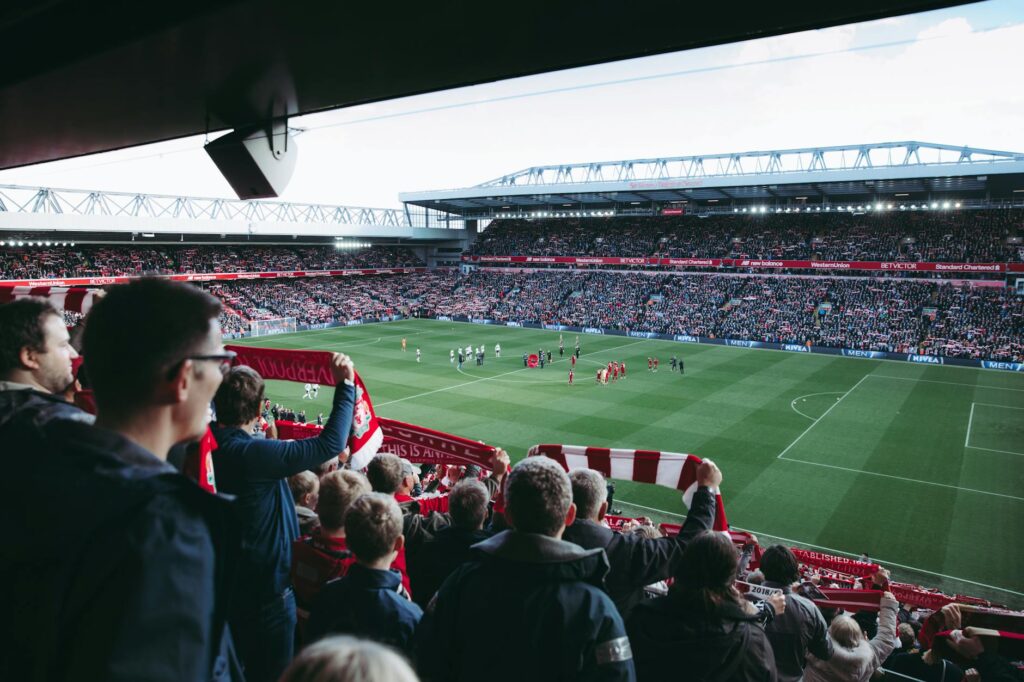In today’s digital age, sports fans have many options when it comes to watching their favorite teams play. However, there is still something special about attending a live sports event.
The excitement of being in the stadium or arena, surrounded by other fans, and cheering on your team is an experience like no other. But with so many options available to fans, it’s more important than ever for sports teams and venues to focus on improving the fan experience.
In this article, we’ll explore some strategies for doing just that. We start with the introduction: The Importance of the Fan Experience
Table of Contents:
- Understanding Your Fans
- Creating a Welcoming Environment
- Improving Concessions and Merchandise
- Enhancing In-Game Entertainment
- Providing Accessible Seating and Amenities
- Embracing Technology
- Building Community
- Engaging Fans Year-Round
- Investing in Staff Training
- Measuring Success
In the end, we have the Conclusion and FAQs.
Intro: The Importance of the Fan Experience
The fan experience is a crucial factor in the success of a sports team or venue.
A positive fan experience can lead to increased attendance, higher revenue from ticket sales, concessions, and merchandise, and greater brand loyalty.
Conversely, a negative fan experience can lead to decreased attendance, reduced revenue, and a damaged reputation.
Increased Attendance
Fans who have a positive experience at a live sports event are more likely to return for future events.
By creating a memorable experience, you can increase the likelihood that fans will come back and become repeat customers. This can lead to higher attendance and increased revenue from ticket sales and concessions.
Higher Revenue
A positive fan experience can also lead to increased revenue from concessions and merchandise.
Fans who are happy with their experience are more likely to spend money on food, drinks, and souvenirs. This can increase revenue for the venue and provide additional opportunities for sponsorships and partnerships.
Greater Brand Loyalty
A positive fan experience can also lead to greater brand loyalty.
Fans who have a memorable experience are more likely to become advocates for the venue and promote it to their friends and family. This can help to build a positive reputation and increase the overall fan base.
Decreased Attendance and Revenue
On the other hand, a negative fan experience can lead to decreased attendance and revenue.
Fans who have a negative experience are unlikely to return for future events and may even leave negative reviews or feedback. This can harm the venue’s reputation and lead to decreased revenue from ticket sales, concessions, and merchandise.
Damaged Reputation
A negative fan experience can also lead to a damaged reputation. With the rise of social media and online review platforms, fans now have a public platform to share their opinions and experiences.
Negative reviews or feedback can harm the venue’s reputation and make it more difficult to attract new fans.
1. Understanding Your Fans
Understanding your fans is essential to improving the overall fan experience at live sports events. It is a “must-know” for everyone aspiring to be a Sports Marketing Manager.
By gathering insights into their needs and preferences, you can tailor the experience to meet their expectations and create a more personalized experience.
Here are some strategies for understanding your fans:
Collecting Fan Feedback
Collecting feedback from fans is a valuable tool for understanding their needs and preferences. This can be done through surveys, online feedback forms, or social media listening.
Analyzing this feedback can provide insights into areas that need improvement, as well as what fans value most about the experience.
Conducting Audience Research
Conducting audience research can provide a more in-depth understanding of your fans. This can include demographic data, such as age, gender, and income, as well as psychographic data, such as attitudes, values, and beliefs.
Audience research can be used to create targeted marketing campaigns and tailor the overall fan experience.
Creating Fan Personas
Creating fan personas is a useful way to segment your audience into different groups based on their needs and preferences. This can include identifying different types of fans, such as families, die-hard fans, or casual spectators.
By understanding the unique needs of each group, you can tailor the experience to meet their expectations.
Tracking Fan Behavior
Tracking fan behavior can provide insights into how fans interact with the venue and the overall experience. This can include tracking attendance, social media engagement, or merchandise sales.
By understanding how fans engage with the brand, you can make data-driven decisions to improve the overall experience.
Leveraging Technology
Technology can provide valuable insights into fan behavior and preferences. This can include using data analytics tools to track fan behavior or mobile apps to gather feedback in real-time.
Additionally, technology can be used to enhance the overall experience, such as offering mobile ordering or in-seat delivery of food and beverages.
2. Creating a Welcoming Environment
Creating a welcoming environment is the foundation of improving the fan experience at live sports events.
The venue should be clean and well-maintained, with clear signage and easy-to-navigate layout. When fans arrive, they should be greeted with a friendly and helpful staff that can assist with any questions or concerns.
Here are some specific strategies for creating a welcoming environment:
Improving Staff Training
The staff members who work at sports venues play a critical role in shaping the fan experience.
Investing in staff training can help ensure that all fans are treated with respect and that any issues or concerns are addressed promptly and professionally. This can include training on customer service, accessibility, and conflict resolution.
Enhancing Venue Aesthetics
The visual appeal of the venue can have a significant impact on the fan experience.
Simple improvements such as adding artwork, murals, or graphics that reflect the team’s history and culture can add a personal touch and make fans feel more connected to the team.
Improving Seating Comfort
Comfortable seating can make a significant difference in the fan experience, particularly for fans who are attending events that last several hours.
Upgrading seats to include extra padding, cup holders, or armrests can help fans feel more relaxed and comfortable.
Streamlining Entry and Exit Processes
Long lines and delays can detract from the fan experience, particularly during peak times like game day.
Streamlining entry and exit processes can help reduce wait times and make the overall experience more enjoyable for fans. This can include adding more entry points, scanning tickets electronically, or using mobile tickets.
Providing Clear Signage
Clear signage can help fans navigate the venue and find their seats or desired amenities. This can include signage that indicates restroom locations, concession stands, or merchandise kiosks.
Additionally, signage that highlights the team’s history or accomplishments can add to the overall experience and build excitement.
3. Improving Concessions and Merchandise
Concessions and merchandise are an essential part of the fan experience at live sports events.
Fans expect a variety of food and drink options at reasonable prices, and they want high-quality merchandise to show their support for their favorite teams. Therefore, it is crucial to improve concessions and merchandise to enhance the overall fan experience.
Food and Drink Options
One way to improve concessions is by offering unique or locally-sourced food and drink options. Fans are always looking for new and exciting food options that they cannot find elsewhere. Offering exclusive items such as local craft beers or specialty hot dogs can set your venue apart from others and create a memorable experience for fans.
Additionally, it is essential to offer a variety of options that cater to different dietary needs, such as vegetarian, vegan, and gluten-free options. By providing a wide range of food options, you can ensure that all fans can enjoy the event and have a positive experience.
Merchandise
Merchandise is another critical aspect of the fan experience. Fans want high-quality merchandise that represents their favorite teams and players. It is important to offer a wide range of merchandise options, including clothing, hats, accessories, and collectibles.
Offering exclusive or limited-edition merchandise can also create a sense of urgency and excitement for fans. This can be achieved through partnerships with players or special promotions during events. Fans will appreciate the opportunity to purchase unique merchandise that is not available anywhere else.
Reasonable Prices
Another critical factor to consider is the price of concessions and merchandise. Fans expect to pay reasonable prices for food, drinks, and merchandise. Offering promotions or discounts on certain items can encourage fans to spend more and increase revenue for the venue.
Staff Training
Finally, it is important to train staff to provide excellent customer service. Friendly and helpful staff can enhance the overall fan experience and leave a positive impression on fans.
Staff should be knowledgeable about the products and services offered and be able to assist fans with any questions or concerns.
4. Enhancing In-Game Entertainment
Enhancing in-game entertainment is an essential part of improving the fan experience. In-game entertainment can create a unique and unforgettable experience for fans.
While the on-field action is the main attraction, the entertainment during breaks can make a significant impact on the overall experience.
Fans expect a range of entertainment options during breaks in the action, and providing this can make the difference between a good and great experience.
Ensure High-Quality Video and Audio
To enhance in-game entertainment, there are several things that sports venues can do.
One option is to invest in high-quality audio and video equipment. This can help to create a more immersive experience for fans and make them feel like they are part of the action. Video boards can display replays, stats, and even fan messages to engage the crowd and create excitement.
An example of value-adding to the fan experience can be seen in snooker, where the audience is offered earpieces, so they can hear the commentary (and the arena remains silent for the players).
Develop Interactive Activities
Another way to enhance in-game entertainment is by providing a variety of entertainment options during breaks in the action. This can include everything from music and dance performances to games and contests.
Interactive activities such as dance competitions, trivia contests, or even social media challenges can keep fans engaged and entertained throughout the game.
Focus On Your Fans
Involving fans in the in-game entertainment can also create a memorable experience. For example, having a fan of the game or a lucky seat promotion can create excitement and anticipation among the crowd.
Fans love to be recognized and appreciated, and involving them in the game experience can make them feel like they are part of the team.
5. Providing Accessible Seating and Amenities
Accessibility is crucial to providing a positive fan experience for everyone, including those with disabilities or mobility issues. To meet the needs of these fans, venues must provide accessible seating and amenities.
Wheelchair-Accessible Seating
Wheelchair-accessible seating is a must for any sports venue. These seats should be located in convenient areas of the venue and offer clear sightlines to the action on the field or court.
Additionally, venues should offer seating options for companions or friends who accompany those with disabilities.
Hearing-Assistive Devices
For fans with hearing impairments, hearing-assistive devices can be a game-changer. These devices amplify sound and make it easier for fans to hear announcements, music, and other in-game entertainment.
Venues should have an ample supply of these devices available for fans to use and have staff trained to assist with their setup.
Accessible Restrooms
Venues should also provide accessible restrooms for fans with disabilities or mobility issues. These restrooms can be located throughout the venue and clearly marked for easy access.
In addition, venues should ensure that the restrooms are clean, well-maintained, and fully stocked with necessary supplies.
6. Embracing Technology
Technology has transformed the way people experience live sports events, and it has become a significant part of the overall fan experience.
Here are some ways venues can embrace technology to enhance the fan experience:
Offering Free Wi-Fi
In today’s connected world, fans expect to be able to stay connected and share their experiences on social media during live events.
Providing free Wi-Fi can make it easier for fans to stay connected and share their experiences with their friends and family. It can also provide an opportunity for venues to engage with fans by offering exclusive promotions or discounts through the Wi-Fi network.
Creating a Mobile App
A mobile app can be a valuable tool for both fans and venues. For fans, a mobile app can provide up-to-date information about the event, including schedules, player information, and scores. It can also allow fans to order concessions and merchandise from their seats, eliminating the need to wait in long lines.
For venues, a mobile app can provide valuable insights into fan behavior and preferences, which can be used to improve the overall fan experience.
Implementing Virtual and Augmented Reality Features
Virtual and augmented reality technologies offer exciting possibilities for enhancing the fan experience at live sports events. These technologies can allow fans to interact with the event in new and exciting ways, such as virtually experiencing a player’s perspective on the field or court.
Virtual and augmented reality features can also provide unique sponsorship opportunities for venues, allowing sponsors to integrate their brands seamlessly into the fan experience.
Using Analytics to Improve the Fan Experience
Data analytics can provide valuable insights into fan behavior and preferences, which can be used to improve the overall fan experience.
By tracking things like attendance, concession sales, and social media engagement, venues can identify areas where improvements can be made. For example, if attendance drops during a certain period of the game, venues can use this information to adjust the in-game entertainment to keep fans engaged.
7. Building Community
Building a sense of community is a crucial component of improving the fan experience at live sports events. Creating a welcoming environment where fans feel like they are part of a larger community can foster a sense of belonging and increase engagement.
Here are some ways to build community at your sports venue:
Host Pre- and Post-Game Events
One way to build a sense of community at your sports venue is to host events before or after the game. This can create a social atmosphere and give fans a chance to connect with one another.
Tailgating parties, fan meet-ups, and player autograph sessions are excellent examples of events that can foster community engagement.
Organize Fan Clubs
Fan clubs are another way to build a sense of community and bring fans together. They can be organized around a particular player, team, or even a specific seating section in the venue.
Fan clubs can be organized online or in-person and can offer exclusive content and experiences to members.
Partner with Local Businesses or Charities
Partnering with local businesses or charities can help to give back to the community and build goodwill among fans. This can include sponsoring local charity events or organizing fundraisers for community organizations.
Collaborating with local businesses to offer discounts or promotions can also create a sense of community and loyalty among fans.
8. Engaging Fans Year-Round
Improving the fan experience is a top priority for sports businesses. However, engaging fans year-round can be a challenge.
Leverage Social Media Platforms
Social media is an effective tool for engaging fans year-round. Platforms such as Facebook, Twitter, Instagram, and LinkedIn offer sports businesses a direct line of communication with their fans.
By creating engaging content and using relevant hashtags, sports businesses can reach a wider audience and build a community around their brand.
Some effective social media strategies for sports businesses include:
- Sharing behind-the-scenes content such as training sessions, team meetings, and locker room moments.
- Running contests and giveaways to encourage fan participation.
- Live-streaming events such as press conferences, Q&A sessions, and meet-and-greets.
- Responding to fan comments and feedback to show that their opinions matter.
Send Regular Email Newsletters
Email newsletters are a great way to keep fans informed and engaged. Sports businesses can use newsletters to share news and updates, exclusive content, and special offers.
By personalizing the content based on the fan’s interests and preferences, sports businesses can create a more engaging and relevant experience for their fans.
Some effective email newsletter strategies for sports businesses include:
- Sending newsletters on a regular basis, such as weekly or monthly.
- Including exclusive content such as interviews, player profiles, and behind-the-scenes footage.
- Offering special discounts and promotions to reward fans for their loyalty.
- Using personalization and segmentation to tailor the content to the fan’s interests and preferences.
Offer Exclusive Content and Experiences
Fans want to feel like they are part of “the inner circle”.
Sports businesses can offer exclusive content and experiences to create a sense of exclusivity and build loyalty among their fans. This can include access to exclusive merchandise, behind-the-scenes tours, meet-and-greets with players, and more.
Some effective strategies for offering exclusive content and experiences include:
- Creating a loyalty program that rewards fans for their engagement and purchases.
- Offering VIP experiences such as pre-game field access or private meet-and-greets with players.
- Selling limited edition merchandise or creating exclusive merchandise for members of the loyalty program.
- Partnering with other businesses to offer unique experiences such as travel packages or dining experiences.
In conclusion, engaging fans year-round is essential for sports businesses to build a strong brand and a loyal fan base.
By leveraging social media platforms, sending regular email newsletters, and offering exclusive content and experiences, sports businesses can create a more engaging and personalized experience for their fans.
9. Investing in Staff Training
The fan experience at a sports venue is more than just the game or event itself. It includes everything from parking and concessions to seating and accessibility.
The staff members who work at sports venues play a critical role in creating a positive fan experience.
Customer Service Training
Customer service training is essential for staff members who interact with fans. This can include ticketing agents, ushers, security personnel, and concession workers.
Effective customer service training should cover:
- How to greet fans and make them feel welcome.
- How to handle complaints and resolve issues.
- How to communicate effectively with fans, especially in high-pressure situations.
- How to provide accurate information about the venue, event, and any amenities.
Accessibility Training
Accessibility is a critical aspect of the fan experience, especially for fans with disabilities. Staff members who work at sports venues should be trained on how to provide accessible services and accommodations.
This can include:
- How to assist fans with mobility impairments, including wheelchair users and those who use mobility aids.
- How to provide accessible seating and assistive listening devices.
- How to communicate effectively with fans who are deaf or hard of hearing.
- How to provide accessible concessions and restroom facilities.
Conflict Resolution Training
Conflict can arise at any event, and staff members need to be trained on how to handle it professionally and effectively.
Conflict resolution training should cover:
- How to identify and defuse potentially volatile situations.
- How to communicate effectively with fans who are upset or angry.
- How to de-escalate conflicts and find a resolution.
- How to work with law enforcement or other authorities if necessary.
Investing in Staff Training
Investing in staff training is an essential component of improving the fan experience at sports venues.
By providing staff members with the skills and knowledge they need to provide excellent customer service, ensure accessibility, and handle conflicts professionally, sports venues can create a positive and welcoming environment for all fans.
Some effective strategies for investing in staff training include:
- Providing regular training sessions for all staff members.
- Encouraging staff members to provide feedback on their training and suggest areas for improvement.
- Offering incentives or rewards for staff members who excel in customer service or conflict resolution.
- Creating a culture of continuous learning and improvement.
In conclusion, staff training is a critical component of improving the fan experience at sports venues.
By investing in customer service, accessibility, and conflict resolution training, sports venues can create a positive and welcoming environment for all fans.
10. Measuring Success
Improving the fan experience is an ongoing process, and it’s essential to measure success and track progress over time.
By tracking attendance, sales, and fan feedback through surveys or online reviews, sports venues can identify areas where improvements are needed and where investments have been successful.
Tracking Attendance
Attendance is a critical metric for measuring the success of a sports venue.
By tracking attendance data over time, venues can identify trends in fan behavior and preferences. This can include:
- Tracking attendance by game, season, or event type.
- Identifying peak attendance times and adjusting staffing and resources accordingly.
- Monitoring ticket sales and promotions to determine what drives attendance.
- Analyzing demographic data to understand who is attending events and where they are coming from.
Monitoring Sales
Sales data can provide valuable insights into fan behavior and preferences.
By monitoring sales data, sports venues can identify which products and services are most popular and adjust their offerings accordingly. This can include:
- Tracking sales of concessions, merchandise, and other products.
- Analyzing pricing data to determine what price points are most effective.
- Identifying trends in fan spending behavior and preferences.
- Monitoring the success of promotional campaigns and special offers.
Collecting Fan Feedback
Collecting fan feedback is essential for understanding what fans like and dislike about their experience at a sports venue.
By collecting feedback through surveys or online reviews, venues can identify areas where improvements are needed and where they are succeeding. This can include:
- Conducting regular surveys of fan satisfaction and feedback.
- Monitoring online reviews and social media comments.
- Tracking complaints and concerns and addressing them promptly.
- Encouraging fan feedback and suggestions for improvements.
Analyzing and Adjusting
Once data is collected, it’s essential to analyze it and adjust strategies accordingly. This can include:
- Identifying areas where improvements are needed and creating a plan for addressing them.
- Adjusting staffing and resources based on attendance and sales data.
- Adapting promotional campaigns and special offers based on sales and fan feedback.
- Continuously monitoring data and adjusting strategies as needed.
In conclusion, measuring success is essential for improving the fan experience at sports venues.
Conclusion and FAQ
The fan experience is critical to the success of any sports team or venue.
By focusing on strategies like creating a welcoming environment, improving concessions and merchandise, enhancing in-game entertainment, providing accessible seating and amenities, embracing technology, building community, engaging fans year-round, investing in staff training, and measuring success, sports venues can improve the fan experience and create a loyal fan base.
FAQ: How to Improve the Fan Experience at Live Sports Events
Some affordable ways to improve the fan experience at a sports venue include offering fan giveaways, creating engaging social media content, improving signage and wayfinding, and offering affordable concessions and merchandise.
Sports venues can make the fan experience more inclusive for people with disabilities by offering accessible seating and parking, providing audio descriptions and closed captioning, offering assistive listening devices, and training staff on disability etiquette and assistance.
Technology plays a significant role in improving the fan experience by offering mobile ticketing, providing access to instant replays and live streams, offering interactive experiences through augmented reality and virtual reality, and providing personalized recommendations and offers based on fan behavior.
Sports teams and venues can build a sense of community around their brand by offering fan events and meet-and-greets with players and staff, engaging fans on social media, supporting local charities and community organizations, and offering exclusive offers and rewards for fan loyalty.
Sports venues can measure success in improving the fan experience by tracking attendance, sales, and fan feedback through surveys or online reviews. By regularly reviewing this data, venues can identify areas where improvements are needed and where investments have been successful.
If you think it sounds fun to improve the fan experience, this guide on how to get a job in sports marketing might be of interest.

Hello! I’m Magnus Berglund, a seasoned trendspotter and proud founder of SportsBizTrends.com.
With over a decade of experience as an independent advisor and consultant, I have specialized in business development and creative marketing within the sports industry. This has, among other things, resulted in a book about sports sponsorship (only available in Swedish for the moment).
If you find my writing interesting, please share it with your colleagues and friends. It would be greatly appreciated!
And yes, I do freelance consulting and provide lectures at industry events, business networks, board meetings, and similar occasions. However, since I also work as a Marketing Manager for an industrial company, I choose the occasions wisely.
That said, don’t hesitate to contact me with your inquiry.
With experience from various assignments in strategy, tactical activations, and valuation of sponsorship (from the grassroots level to the English Premier League), I am happy to share my insights and ideas in this fast-paced industry.
For more information about me and my work, including my contact details, please visit the About page, or connect with me via LinkedIn.








